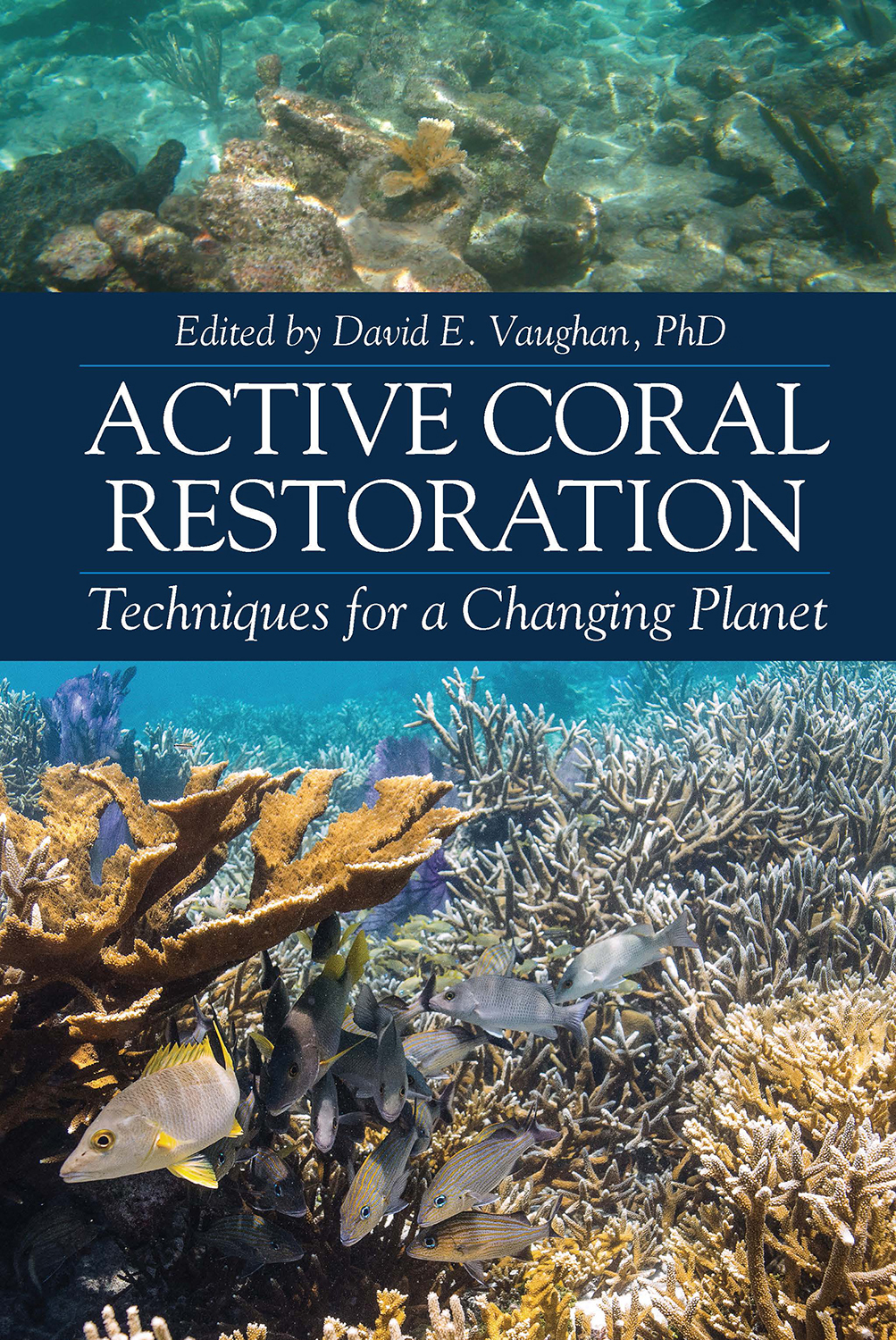Active Coral Restoration
$89.95
Techniques for a Changing Planet
Edited by David E. Vaughan, PhD
Hardcover, 7×10, 610 pages
ISBN: 978-1-60427-143-0
March 2021
Description
Coral reefs around the world are in peril and approximately half of the world’s coral cover has been lost since 1970 due to impacts from climate change, pollution, disease, and fishing practices that can destroy entire reefs. This rate of decline has been quite rapid, particularly when compared to the average rate of growth for a healthy coral in the wild. This ratio of decline to growth had diminished hope among scientists that coral reefs could eventually restore themselves over time. However, with the new technologies of active coral restoration, optimism has returned. Active coral restoration includes procedures for growing corals fast and efficiently, while also being able to genetically select for traits of natural resistance and resiliency that help them to survive water temperature increases, bleaching, and diseases. These cultured corals are grown in various types of nurseries and then outplanted to restoration sites. Until now, there has not been a book which brings to light this marvelous, game-changing practice of active coral restoration.
Active Coral Restoration: Techniques for a Changing Planet is a timely, comprehensive volume that provides a foundational understanding of the current and emerging practices and technologies used for active coral reef restoration projects around the world. Edited by David E. Vaughan, this work contains contributed chapters written by some of the foremost authorities on coral reef restoration. It is a must-have for all practitioners of coral reef restoration, including research scientists, resource managers, aquarists, volunteers, students of marine science, and policymakers.
Key Features
- First-ever comprehensive volume on the practice of active coral reef restoration
- Provides an overview of the history of coral restoration and the transition to active coral restoration
- Demonstrates new and emerging methods and technologies for active coral restoration, including fragmentation and micro-fragmentation, coral fusion and skinning, coral larvae capture and rearing, and assisted evolution for coral resistance and resilience
- Offers strategies on how to set up land- and field-based coral nurseries
- Contains over 200 color figures and photographs to illustrate important concepts and procedures
- Includes 11 relevant case studies from around the world to highlight key principles and success stories within restoration projects; case studies include Belize, the Seychelles, the Red Sea, Mexico, Australia, Costa Rica, the Line Islands, Indonesia, Florida, Bonaire, and the Dominican Republic
- WAV includes valuable downloadable record sheets for environmental data, daily raceway maintenance, coral growth and health, mechanical maintenance at land-based nursery, and field nursery/outplant site for coral growth and health—available from the Web Added Value™ Download Resource Center
About the author(s)
Dr. David E. Vaughan has held positions in aquaculture research and development for over 30 years. He directed the Aquaculture Division at Harbor Brach Oceanographic Institution (HBOI) for 17 years, including the design, build, and operation of the 60-acre HBOI Aquaculture Development Park, the world’s only completely recirculating center for aquaculture training and demonstration. He is often cited with creating the R&D and scale-up of clam farming technologies in Florida and directing the training programs and operations of the nation’s largest hatchery to produce clams used for retraining displaced fisherman. Vaughan founded and developed Oceans, Reefs, and Aquariums Inc. (ORA), a large marine ornamental production facility for producing thousands of reef fish as well as hard and soft corals for the aquarium trade. He has also worked with Philippe Cousteau at Earth Echo International on international coral reef restoration initiatives.
As the Executive Director of the Mote Marine Laboratory Elizabeth Moore Center for Coral Reef Research and Restoration in the Florida Keys for 15 years, he started the Coral Reef Restoration Program. Through this program, he was heralded with being the first to develop the new technology of coral micro-fragmentation. Through micro-fragmentation, massive corals grow very quickly to reproductive size, which dramatically improves the rate at which coral reefs can be restored. In 2017 he received the Chicago Field Museum Parker/Gentry Award as “Conservationist of the Year” for his work with coral restoration and serves as an adjunct scientist at the Field Museum of Chicago.
Dr. Vaughan is now the Founder and President of Plant a Million Corals Foundation and is actively helping people around the world to use micro-fragmentation as a scalable tool for reef restoration. He is designing and building transportable land-based coral nursery systems that can be shipped to locations across the globe to train others in this game-changing technology for restoration. Dave plans to continue sharing his discovered technologies and passion for coral restoration to fulfill his goal of planting a million corals before he retires.
Table of Contents
Foreword: Philippe Cousteau
Section I. Overview
Chapter 1: Introduction. David E. Vaughan
Chapter 2: History of Reef Restoration. Adam Smith, Boze Hancock, Nathan Cook, and David E. Vaughan
Chapter 3: The Quandary for Active and Passive Reef Restoration in a Changing World. Buki Rinkevich
Chapter 4: Live Rock Farmer to Live Coral Farmer. Ken Nedimeyer
Section II. Biological Considerations and Methodologies
Chapter 5: Land and Field Nurseries. David E. Vaughan
Chapter 6: Asexual Coral Propagation – Fragmentation and Micro-fragmentation. David E. Vaughan
Chapter 7: Coral Fusion: Harnessing Coral Clonality for Reef Restoration. Zac H. Forsman, Christopher Page, and David E. Vaughan
Chapter 8: Sexual Reproduction and Rearing Corals for Restoration. Christopher Page, Nicole D. Fogarty, and David E. Vaughan
Chapter 9: Human Assisted Evolution and Coral Reef Resilience. Hanna R. Koch
Chapter 10: Genetics Considerations for Coral Reef Restoration. Hanna R. Koch
Section III. Case Studies from Around the World
Chapter 11: Belize: Fragments of Hope. Lisa Carne and Maya A. Trotz
Chapter 12: Indian Ocean: Seychelles. Sarah Frias-Torres, Claude Reveret, Phanor Montoya-Maya, and Nirmal J. Shah
Chapter 13: Active Coral Reef Restoration in Eilat, Israel: Reconnoitering the Long-term Prospectus. Yael B. Horoszowski-Fridman and Buki Rickevich
Chapter 14: Active Reef Restoration in the Mexican Caribbean: 15 Year Timeline. Claudia Padilla-Souza, Jaime González-Cano, Juan Carlos Huitron Baca, and Roberto Ibarra-Navarro
Chapter 15: Active Coral Reef Restoration in Australia. Adam Smith, Nathan Cook, and Johnny Gaskell
Chapter 16: Reef Restoration in the Eastern Tropical Pacific: A Case Study in Golfo Dulce, Costa Rica. J.A. Klypas, T. Villalobos-Cubero, J.A. Mrin-Moraga, A. Teran, J. Cortes, and J.J. Alvarado
Chapter 17: Line Islands, Kiribati. Austin Bowden-Kerby, Taratau Kirata, and Laurence Romeo
Chapter 18: Indonesia: Mars Assisted Reef Restoration System (MARRS). D. Smith, F. Mars, S. Williams, J. van Oostrum, A. McArdle, S. Rapi, J. Jompa, and N. Janetski
Chapter 19: Hurricane Impacts on Reef Restoration: The Good, Bad and the Ugly. Jane Carrick, Diego Lirman, et al.
Chapter 20: Bolstering Reef Restoration Efforts: A Multifaceted Approach from Reef Renewal Foundation, Bonaire. Francesca Virdis, Bridget Hickey, and Ken Nedimeyer
Chapter 21: Punta Cana, Dominican Republic. Jake Kheel and David E. Vaughan
Section IV. The Future of Coral Reef Restoration
Chapter 22: Emerging Technologies. David E. Vaughan and Ken Nedimeyer
Chapter 23: Making Restoration Meaningful: A Vision for Working at Multiple Scales to Help Secure a Future for Coral Reefs. Les Kaufman, Ilsa Kufner, Tom Moore, and Tali Vardi
Appendix 1: Notes for Record Keeping by Donna Vaughan
Appendix 1A: Data Sheet: Record of Daily Environmental Data
Appendix 1B: Data Sheet: Record for Daily Raceway Maintenance
Appendix 1C: Data Sheet: Monthly Record for Coral Growth and Health
Appendix 1D: Data Sheet: Record for Mechanical Maintenance at a Land-based Nursery
Appendix 1E: Data Sheet: Record for Field Nursery/Outplant Site for Coral Growth and Health
Index
Reviews
“This inspired volume is a practical guide for today’s coral restoration practitioner and provides the most current techniques for restoring coral reefs around the world. It is a must read for anyone interested in the exciting field of active coral restoration. Amazingly, it demonstrates that coral reefs need not be lost and that there is always hope for the future.”
—Philippe Cousteau, Founder, EarthEcho International
“In the span of a few decades, thousands of years of coral growth have succumbed from stress due to human activities. Today, scientists have been working very hard to determine the most efficient ways to restore them. In this timely and comprehensive volume, they present the most current methods and procedures used to grow coral and successfully restore reefs—faster than ever before.”
—Billy D. Causey, MPA Practitioner, Consultant, and first superintendent of the Florida Keys National Marine Sanctuary
You may also like…
Related products
-

Worship Space Acoustics
Retail Price: $89.95$79.95 Add to cart -

Intellectual Property for Integrated Circuits
Retail Price: $99.95$89.95 Add to cart -

Elastic Beam Calculations Handbook
Retail Price: $119.95$99.95 Add to cart -

Dendroecology
Retail Price: $79.95$69.95 Add to cart -

Architectural Acoustics
Retail Price: $64.95$54.95 Add to cart


